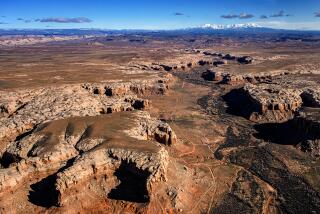NONFICTION - July 26, 1992
- Share via
THE BEAUTIFUL AND THE DANGEROUS: Encounters with the Zuni Indians by Barbara Tedlock (Viking: $23; 336 pp.). Look at the Zuni reservation in New Mexico from a dirt roadside and you will see rudimentary shelter on arid land: rusty old trucks parked next to stone houses on rangeland desiccated in the 19th Century by damming and denuded of juniper, sagebrush and pinon in the 20th by land management programs. Look at the Zunis through the eyes of anthropologist Barbara Tedlock, however, and you will see a culture as rich and vibrant as the land is desolate and defeated.
Happily, “The Beautiful and the Dangerous” is not another tribute to a culture on the wane because the Zunis, drawing upon their ancient tradition of mediating between cultures (and even between sexes, as Will Roscoe showed in last year’s book “The Zuni-Man-Woman”), have had considerable success in blending the old with the new. This is clear from the moment in 1968 when Tedlock first arrives in the adobe, mud and straw house of the Zuni family she portrays in these pages. On one wall is posted a slick magazine photo of President Kennedy meeting Pope Paul VI. The TV is tuned to Star Trek. And the family’s son, sporting a Beatles haircut, is humming “All You Need Is Love.”
Tedlock never explicitly points out that the Zunis are envoys between the old and new. More novelist than ethnographer, she rejects the classic anthropological approach of “participant observation,” which aims to get at objective truth through scientific analysis, and instead records her immediate sensual reactions to Zuni culture, from taste (“I munched on a fistful of cilantro followed by a radish, lingered over the iced tea with wild mint”) and sight (“Up the dirt road under a turquoise sky past a row of adobe ovens and on into the old pueblo, we arrived at a huge stone house”) to touch (the family’s five-year-old daughter “spent her dinner hour making eyes, giggling, and touching--first with a scallion and later with a carrot--my long stringy strawberry blond hair”).
We lose in ethnographic precision what we gain in novelistic vividness. Folk medicine remedies are exuberantly presented as cure-alls, for instance, whereas other anthropologists might have studied the way they supplant some modern medical procedures but not others. Tedlock’s stories of how the Zunis negotiate between old and new nevertheless are a joy to read, as in this explanation from Hapiya, the elder of the family, about why the Apollo 13 astronauts were forced to turn back to Earth midway through their mission. The Moon Mother, Hapiya explains, got mad and threw dirt and rocks at them: “Hapiya’s logic, as usual, was impeccable. Witches travel in whirlwinds at the center of dust storms. The entire NASA space program is white witchcraft; therefore, the Apollo 13 astronauts who turned back toward Earth, causing whirlwinds, were also witches. And witches are harbingers of the coming of death to the world, a time when all of our man-made things--hoes, axes, drills, anvils, pliers, hammers, knives, forks, guns, cars, trucks, rockets, blenders, toasters, lamps, washing machines, radios, televisions, typewriters, and computers--will revolt, the moon and stars will fall, and we’ll all be boiled to death in hot rain.”
More to Read
Sign up for our Book Club newsletter
Get the latest news, events and more from the Los Angeles Times Book Club, and help us get L.A. reading and talking.
You may occasionally receive promotional content from the Los Angeles Times.










